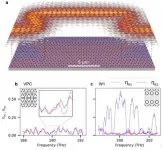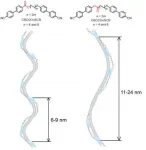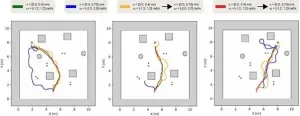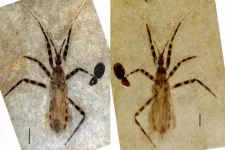NUS engineers create 'smart' aerogel that turns air into drinking water
One kilogramme of the new material generates enough drinking water to meet a household's daily need, and does not require any external power source
2021-01-19
(Press-News.org) Some say future wars will be fought over water, and a billion people around the world are already struggling to find enough water to live.
Now, researchers at the National University of Singapore (NUS) are coming to the rescue. They have created a substance that extracts water from air without any external power source.
In the earth's atmosphere, there is water that can fill almost half a trillion Olympic swimming pools. But it has long been overlooked as a source for potable water.
To extract water from this under utilised source, a team led by Professor Ho Ghim Wei from the NUS Department of Electrical and Computer Engineering created a type of aerogel, a solid material that weighs almost nothing. Under the microscope, it looks like a sponge, but it does not have to be squeezed to release the water it absorbs from the air. It also does not need a battery. In a humid environment, one kilogramme of it will produce 17 litres of water a day.
The trick is in the long, snakelike molecules, known as polymers, building up the aerogel. The special long-chain polymer consists of a sophisticated chemical structure that can continuously switch between attracting water and repelling water. The 'smart' aerogel autonomously gathers water molecules from the air, condenses them into a liquid and releases the water. When there is sunshine, the smart structure can further boost the water release by transitioning to a complete water-hating state. And it is very good at that. 95 percent of the water vapour that goes into the aerogel comes out as water. In laboratory tests, the aerogel gave water non-stop for months.
The researchers tested the water, and found that it met World Health Organization's standards for drinking water.
Other scientists have previously devised ways to extract water from air, but their designs had to be powered by sunlight or electricity, and had moving parts that had to be opened and closed.
The NUS researchers published their creation in the journal Science Advances on 16 October 2020. They are now looking for industry partners to scale it up for domestic or industrial use. Maybe it could even find a place in endurance sports or survival kits, for example.
"Given that atmospheric water is continuously replenished by the global hydrological cycle, our invention offers a promising solution for achieving sustainable freshwater production in a variety of climatic conditions, at minimal energy cost," shared Prof Ho.
INFORMATION:
[Attachments] See images for this press release:
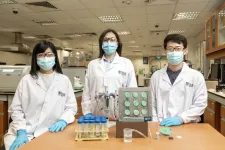
ELSE PRESS RELEASES FROM THIS DATE:
2021-01-19
University of South Australia scientists have developed the world's first test to accurately predict mood disorders in people, based on the levels of a specific protein found in the brain.
Links between low levels of mature brain-derived neurotrophic factor (mBDNF) and depression are well known but, until now, it hasn't been possible to distinguish between the three forms of the BDNF protein in blood samples.
The mature form promotes the growth of neurons and protects the brain, but the other two BDNF forms - its precursor and the prodomain of BDNF - bind to different receptors, causing nerve degeneration ...
2021-01-19
SINGAPORE, 19 January 2021 - Duke-NUS Medical School researchers, together with collaborators in Singapore, have designed armoured immune cells that can attack recurring cancer in liver transplant patients, while temporarily evading immunosuppressant drugs patients take to avoid organ rejection. The findings were published in the journal Hepatology.
Hepatocellular carcinoma is the most common type of primary liver cancer and the sixth most common cancer worldwide. It often develops in people with chronic liver disease following hepatitis B infection.
A common treatment for hepatocellular carcinoma is to completely ...
2021-01-19
Topologically tailored photonic crystals (PhC) have opened up the possibility for attaining robust unidirectional transport of classical and quantum systems. The demand for unprecedented guiding capabilities that support unhindered transport around imperfections and sharp corners at telecom wavelengths, without the need for any optimization, is fundamental for efficient distribution of information through dense on-chip photonic networks. However, transport properties of experimental realizations of such topologically non-trivial states have been inferred by transmission measurements and even though robustness ...
2021-01-19
Overview:
A team of researchers led by Assistant Professor Yuki Arakawa (Toyohashi University of Technology, Japan) has successfully developed sulfur-containing liquid crystal (LC) dimer molecules1) with oppositely directed ester bonds, which exhibit a helical liquid crystal phase, viz. twist-bend nematic (NTB) phase, 2) over a wide temperature range, including room temperature. Collaboration with a team at the Advanced Light Source research facility (Lawrence Berkeley National Laboratory, USA) revealed that the ester bond direction in the molecular structures largely impacts the pitch lengths of helical nanostructures in the NTB phase. It is expected that this molecular design ...
2021-01-19
Overview:
A research group from the Active Intelligent System Laboratory (AISL) at Toyohashi University of Technology (TUT) has proposed a new framework for training mobile robots to quickly navigate while maintaining low collision rates. The framework combines deep reinforcement learning (DRL) and curriculum learning in the training process for robots to learn a fast but safe navigation policy.
Details:
One of the basic requirements of autonomous mobile robots is their navigation capability. The robot must be able to navigate from its current position to the specified target position ...
2021-01-19
CHAMPAIGN, Ill. -- The fossilized insect is tiny and its genital capsule, called a pygophore, is roughly the length of a grain of rice. It is remarkable, scientists say, because the bug's physical characteristics - from the bold banding pattern on its legs to the internal features of its genitalia - are clearly visible and well-preserved. Recovered from the Green River Formation in present-day Colorado, the fossil represents a new genus and species of predatory insects known as assassin bugs.
The find is reported in the journal Papers in Palaeontology.
Discovered in 2006 by breaking open ...
2021-01-19
Simple vision tests can predict which people with Parkinson's disease will develop cognitive impairment and possible dementia 18 months later, according to a new study by UCL researchers.
The study, published in Movement Disorders, adds to evidence that vision changes precede the cognitive decline that occurs in many, but not all, people with Parkinson's.
In another new study published today in Communications Biology, the same research team found that structural and functional connections of brain regions become decoupled throughout the entire brain in people with Parkinson's disease, particularly among people with vision problems.
The ...
2021-01-19
There are high hopes for the next generation of high energy-density lithium metal batteries, but before they can be used in our vehicles, there are crucial problems to solve. An international research team led by Chalmers University of Technology, Sweden, has now developed concrete guidelines for how the batteries should be charged and operated, maximising efficiency while minimising the risk of short circuits.
Lithium metal batteries are one of several promising concepts that could eventually replace the lithium-ion batteries which are currently widely used - particularly in various types of electric vehicles.
The big advantage of this new battery type is that the energy density can be significantly ...
2021-01-19
New research suggests a unique program called Moms2B at The Ohio State University Wexner Medical Center shows a reduction in adverse pregnancy outcomes in communities disproportionately affected by these public health issues.
The study, led by researchers Courtney Lynch and Erinn Hade and published in the Journal of Maternal and Child Health, indicates that women who attended at least two Moms2B sessions may have lower rates of preterm birth, low birth weight and infant mortality compared to women who only received individual care.
"When we started the program 10 years ago, ...
2021-01-19
New study identifies a bizarre new species suggesting that giant marine lizards thrived before the asteroid wiped them out 66 million years ago.
A new species of mosasaur - an ancient sea-going lizard from the age of dinosaurs - has been found with shark-like teeth that gave it a deadly slicing bite.
Xenodens calminechari, from the Cretaceous of Morocco, had knifelike teeth that were packed edge to edge to make a serrated blade and resemble those of certain sharks. The cutting teeth let the small, agile mosasaur, about the size of a small porpoise, punch above its weight, cutting fish in half and taking large bites from bigger animals.
Dr Nick Longrich, Senior Lecturer at the Milner Centre for Evolution at the University of Bath and lead author on ...
LAST 30 PRESS RELEASES:
[Press-News.org] NUS engineers create 'smart' aerogel that turns air into drinking water
One kilogramme of the new material generates enough drinking water to meet a household's daily need, and does not require any external power source

